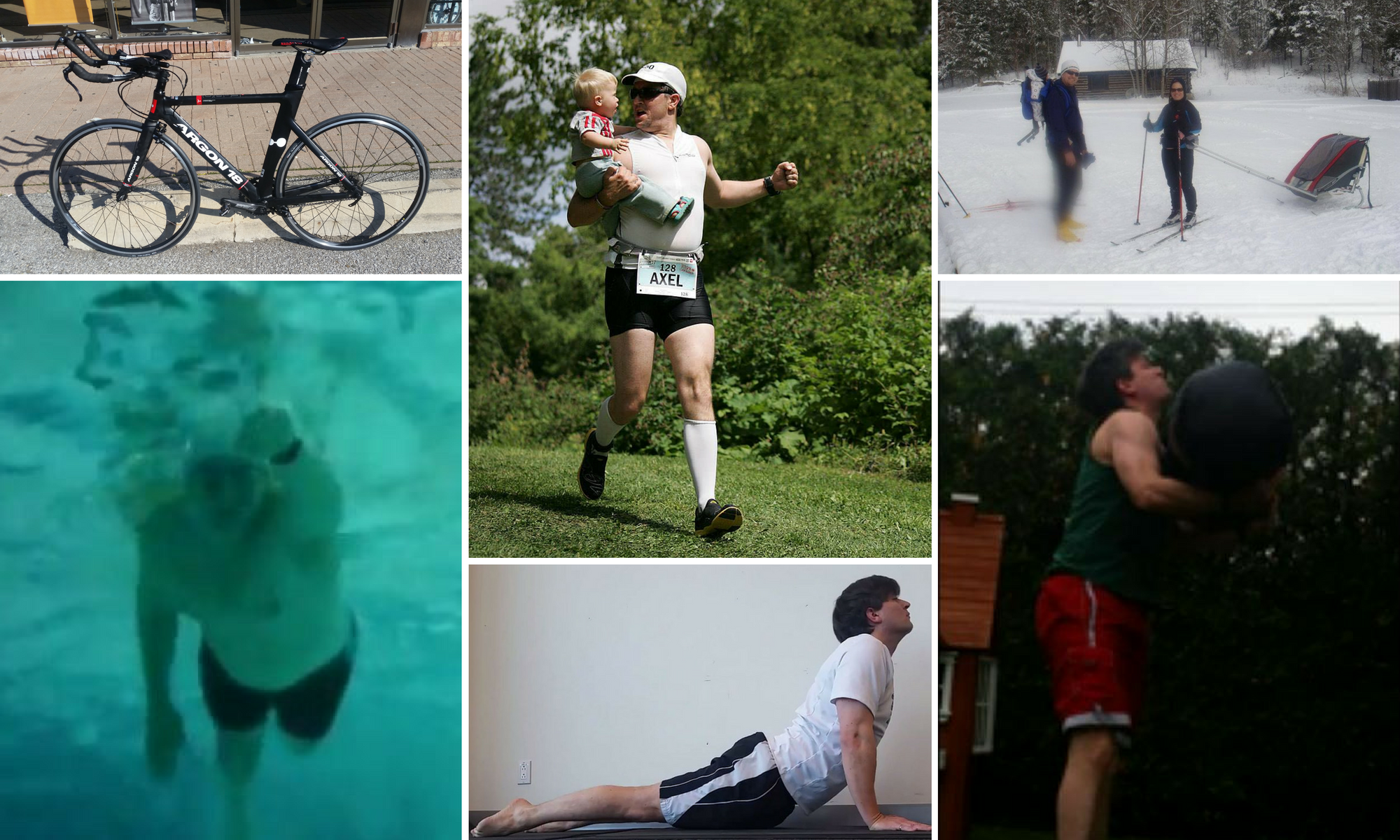With the off-season in full swing, we’re looking at contending with less daylight, and colder temperatures – the temptation to cocoon is overwhelming. Still one of the things you can do from the comfort of your home nowadays is train/exercise/workout. There’s tons of articles and posts about what exercise gear to equip your home with (and I may write one myself soon enough), today I’m going to talk about options for electronic media. Whether you’re on a bike trainer, watching a workout DVD, or simply want tunes while you exercise, you’ll probably need a way to play media. What kinds of tech could you use? Warning: this might get a little technical; leave a question in the comments if something is unclear.
- Tablet computer. I managed to balance my iPad quite nicely on my aerobars while I was on the bike trainer. I used Netflix to watch a TV show (can’t remember which one) for some slow spinning, then switched to the Bit Timer app for a Tabata to finish.
- DVD Player (& TV of course). There are Workout videos for strength, toning, cardio, as well as Yoga, Pilates and Biking/Spinning. You can play music CDs or even watch a your favourite TV show while on the trainer (or treadmill or elliptical if you have one). Personally I don’t use my workout videos as much as I’d like, and watching TV is something I prefer to do when there isn’t other noise (like my own grunting, or the whir of my bike) to interfere with my enjoyment of it. This option is honestly a little primitive (no Internet?) by today’s standards.
- Laptop. It usually has a connection to the internet so Youtube videos of workouts and techniques (and there are more and more of these nowadays), plus playing DVDs and CDs is generally no problem. It could have a music collection on there, or simply display a workout you got from a blog or website. I’m a little nervous about having the laptop around exercise equipment – I have visions of sweat in the keyboard or it simply getting broken. It’s a little hard to find a good spot for it, but it’s still a great option.
- Home Theatre PC (HTPC). Ah, the Cadillac option. For a while I had a PC with a quiet case hooked up to the home theatre/TV, and it was bliss. This thing had a video capture card (for recording TV) and was running MythTV. MythTV is free software that implements PVR recording (provided you have that capture card I mention) which automatically flags and skips commercials. So, a PVR that I don’t pay the TV company a rental fee for, and I never see commercials. I also had music and some exercise videos ripped onto the hard drive, so when I wanted a Yoga session, I could press play without waiting for the DVD to spin up and be read – instant access. Unfortunately, the motherboard of this machine blew and replacing it meant basically rebuilding the machine from scratch. I wasn’t willing to put in the time, effort and cash, so I found a cheaper alternative.
- Home Media Player – These aren’t fully fledged computers, more like hard-drives that have network capability and the right drivers for streaming/playing various media. An Apple TV might count in this category. The one I’ve been using is the Cirago CMC3000; it has video capture capability so I can record shows, but it’s not as good as the MythTV because I have to manually program what time to record without an on-screen guide – it only records what the set-top box is playing (meaning I have to program the set-top box too to be on the right channel at the right time). The MythTV had its own tuner so I could just pick say, ‘How I Met Your Mother’ and it would tune the correct channel at the right time. Still, I’m using it to record shows and fastforward commercials, so that’s good. It can stream media from my desktop and through third party software I can also play Netflix on it. If I rip my workout DVDs to my computer, I should be able to stream them from the Cirago, or even simply copy the files over to it; it can be a network mapped hard-drive too.
Let’s see what’s there:
- Flexible Warrior: Yoga for Triathletes Vol 1, 2, 4 & 5. Previously mentioned on this blog.
- Fit2Touch with Edna and Peter
- Real Rides Race Day from CycleOps – came with my bike trainer
- Spinervals for the trainer
- Various Pilates DVDs – some were gifts…some came with the Swiss Ball…
- Missing: the DVD that came with our Bosu
That’s a little embarrassing… some are still in the plastic! Let’s hope the season is kind to me and the videos! If I wanted to add to the collection, I thought I’d share that Beachbody let me know that they have some new products. Of the ones they mentioned these were the most interesting (N.B. without having tried these products, I cannot endorse or recommend them, I am merely linking to acknowledge their existence).
- Les Mills Combat: They have Les Mills classes at Goodlife Fitness, where I’m a member. My favourite group class is Body Combat; the cardio burn rate is unparalleled, and it’s a heap of fun, scratching my martial arts itch. I haven’t found a class that meets my schedule lately, so having one at home would be pretty attractive.
- Insanity Asylum Volume 2: The Insanity series are unique in that they offer drills that are meant to increase actual athletic performance (speed, power, agility, etc.) rather than simply build muscle or burn fat. They would probably be more useful for a performance minded multi-sport athlete.
I hope that gives some of you some ideas…. what kinds of electronic media are you using to stay in shape?















